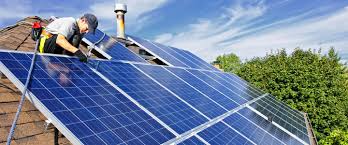Harnessing Solar Power: A Comprehensive Guide to Photovoltaic Systems

Introduction to Photovoltaic Systems
In the quest for sustainable energy sources, photovoltaic (PV) systems have emerged as a frontrunner. These systems utilize solar panels to convert sunlight into electricity, offering a clean and renewable energy solution for homes and businesses alike. This comprehensive guide will explore the ins and outs of photovoltaic systems, from their components to their installation and benefits.
Understanding Photovoltaic Technology
At the heart of every photovoltaic system are solar panels, which contain photovoltaic cells that convert sunlight into electricity through the photovoltaic effect. These cells are typically made from semiconductor materials like silicon and generate direct current (DC) electricity when exposed to sunlight.
Components of a Photovoltaic System
In addition to solar panels, a typical photovoltaic system consists of several key components, including inverters, mounting hardware, and electrical wiring. Inverters are responsible for converting the DC electricity generated by the solar panels into alternating current (AC) electricity suitable for use in homes and businesses.
Types of Photovoltaic Systems
There are several types of photovoltaic systems available, each with its own unique characteristics and applications.
Grid-Connected Systems
Grid-connected photovoltaic systems are the most common type and are designed to operate in conjunction with the electrical grid. These systems can feed excess electricity back into the grid, allowing homeowners to earn credits for the energy they produce.
Off-Grid Systems
Off-grid photovoltaic systems are standalone systems that operate independently of the electrical grid. These systems are typically used in remote areas where access to the grid is limited or nonexistent, such as cabins, RVs, and boats.
Hybrid Systems
Hybrid photovoltaic systems combine solar power with other renewable energy sources, such as wind or hydroelectric power. These systems are designed to provide a more reliable and consistent source of electricity, particularly in areas with fluctuating sunlight or limited solar resources.
Designing a Photovoltaic System
Designing a photovoltaic system involves several key steps, including site assessment, system sizing, and component selection.
Site Assessment
Before installing a photovoltaic system, it's essential to assess the site to determine its suitability for solar energy production. Factors such as shading, orientation, and roof pitch can all impact the performance of the system.
System Sizing
The size of a photovoltaic system is determined by the energy needs of the property and the available roof space for solar panels. By calculating energy consumption patterns and available sunlight, installers can determine the optimal size for the system.
Component Selection
Choosing the right components is crucial for the performance and longevity of a photovoltaic system. From high-quality solar panels to efficient inverters and mounting hardware, each component plays a vital role in the overall functionality of the system.
Installing a Photovoltaic System
Once the design phase is complete, the installation process can begin.
Roof Preparation
Before installing solar panels, the roof must be inspected and prepared to ensure it can support the weight of the panels and withstand weather conditions. Any necessary repairs or reinforcements should be made before proceeding with installation.
Panel Mounting
Solar panels are mounted on the roof using specialized racking systems that are securely attached to the roof structure. Proper placement and orientation are critical for maximizing energy production and system efficiency.
Electrical Connection
After the panels are mounted, they are connected to the electrical system of the property. This involves wiring the panels to inverters, which convert the DC electricity generated by the panels into AC electricity usable by homes and businesses.
Monitoring and Maintenance
Once the photovoltaic system is installed, regular monitoring and maintenance are essential for optimal performance.
Monitoring
Monitoring software allows homeowners to track the performance of their photovoltaic system in real-time. By monitoring energy production and consumption, homeowners can identify any issues or inefficiencies and take corrective action as needed.
Maintenance
While photovoltaic systems require minimal maintenance, routine inspections and cleaning are necessary to ensure optimal performance. This may include cleaning the solar panels to remove dirt and debris and inspecting electrical connections for signs of wear or damage.
Benefits of Photovoltaic Systems
There are numerous benefits to installing a photovoltaic system, both for homeowners and the environment.
Cost Savings
Photovoltaic systems can significantly reduce or eliminate electricity bills, saving homeowners money in the long run. Additionally, many governments and utilities offer incentives and rebates for installing solar panels, further reducing the upfront cost of installation.
Environmental Impact
By generating electricity from sunlight, photovoltaic systems produce zero emissions and help reduce reliance on fossil fuels. This can significantly reduce carbon emissions and mitigate the harmful effects of climate change.
Energy Independence
Photovoltaic systems provide homeowners with a reliable and renewable source of electricity, reducing dependence on the electrical grid. This can help protect against power outages and price fluctuations in the energy market.
Conclusion
Photovoltaic systems offer a clean, renewable, and cost-effective solution for meeting our energy needs. By harnessing the power of the sun, homeowners can reduce their carbon footprint, save money on energy bills, and enjoy greater energy independence. With proper planning, installation, and maintenance, photovoltaic systems can provide reliable electricity for years to come.
